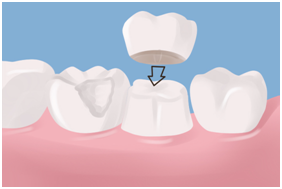Crowns and Bridges

CROWNS
Crowns are used to fully encase or cover the entire visible portion of a tooth that lies at and above the gum line. It is a tooth-shaped “cap” placed over a tooth to cover it so as to restore its shape, size, strength and improve its appearance. Crown can be made of metal (gold or other alloys), stainless steel, porcelain, all resin or ceramic.
A dental crown can be used to cover a misshapen or discolored tooth, protect a weak tooth, restore a broken or worn tooth, cover a tooth with a large filling, hold a dental bridge in place, cover a dental implant or cover a tooth that’s had a root canal procedure. In children it can be used on primary (milk) teeth to save a tooth so damaged by decay that it can’t support a filling, to protect a teeth at high risk for tooth decay, etc. Dental crowns can last between 5 to 15 years on an average, depending on how well you follow good oral hygiene practices and habits.
Procedure to place a crown usually takes two dental visits. During the first visit, the tooth and surrounding gums and tissues are examined and prepared. The tooth is filed, space to place the crown is created, an impression of the tooth and surrounding structures is taken and sent to the laboratory to prepare the crown. Meanwhile a temporary crown is placed to cover and protect the prepared tooth while the crown is being made. During the second visit, the temporary crown is removed and after checking the fit and color of the permanent crown, it is cemented in place.

BRIDGES
Bridges, also called as fixed partial denture, are used to replace missing teeth with artificial teeth. Bridges can be made of gold, alloys, porcelain, or a combination. It is a structure between two crowns to fill the gap between missing teeth. Bridges can help to restore your smile, restore your ability to properly chew and speak, maintain the shape of your face, distribute the forces in your bite properly by replacing missing teeth and prevent remaining teeth from drifting out of position.
There are three main types of dental bridges namely traditional bridges (creating a crown for the tooth or implant on either side of the missing tooth with a replacement tooth (Pontic) in between), cantilever bridges (when there are adjacent teeth on only one side of the missing tooth or teeth) and maryland bonded bridges (made of plastic teeth and gums supported by a metal framework).
Getting a dental bridge involves two visits to the dentist. The first visit involves recontouring the teeth by removing a portion of enamel to allow room for a crown to be placed over them, taking impressions of your teeth to serve as a model for making the bridge, pontic, and crowns will be made by a dental laboratory and placement of a temporary bridge to protect the exposed teeth and gums. During the second visit, your temporary bridge is removed and the new permanent bridge is cemented into place after checking if it is a proper fit.
Dental bridges can last five to 15 years and even longer with good oral hygiene and regular checkups.

